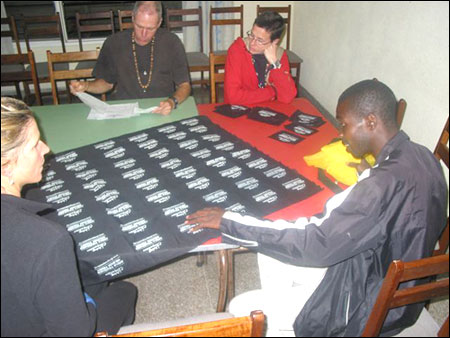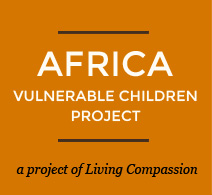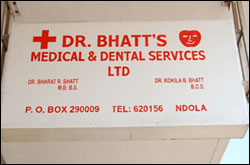 Friday morning began with a six-hour blog marathon. While the blog was being written two retreatants went in search of the dentist who had been recommended by a local musungu. They learned that she was not currently available because she was spending time with her son who was returning the next day to his home in San Jose, California. (We were immediately heartened.) They were encouraged by her medical doctor husband to return later that afternoon for a consultation. The dentist made a special trip in that afternoon for the examination. We were comforted to know from our own experience that it is possible to get high quality medical and dental care here in Ndola.
Friday morning began with a six-hour blog marathon. While the blog was being written two retreatants went in search of the dentist who had been recommended by a local musungu. They learned that she was not currently available because she was spending time with her son who was returning the next day to his home in San Jose, California. (We were immediately heartened.) They were encouraged by her medical doctor husband to return later that afternoon for a consultation. The dentist made a special trip in that afternoon for the examination. We were comforted to know from our own experience that it is possible to get high quality medical and dental care here in Ndola.
Dave and Alex left at noon for Kantolomba. The bloggers kept blogging, then left for a successful visit to the District Commissioner to check on those elusive documents. Success! We now have in our possession a copy of the latest census, Ndola’s Strategy Development Plan, and the District Situation Analysis (the Copperbelt). These documents will help us create effective and appropriate programs for Kantolomba.
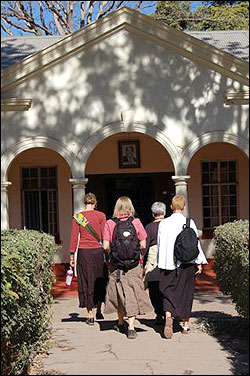
We had been told that the parents of the children we are feeding would meet in the morning to begin working on the improvements to the school. What Dave and Alex found when they arrived exceeded even our most optimistic expectations. Imagine dozens of people (most of them women) dressed in colorful African clothes, up to their knees in a long ditch, digging energetically with all sorts of home-made implements. All the while they worked they talked and laughed and sang, and played with the hordes of children lining the road. By the time we arrived they had already dug half of the two hundred meter trench that will hold the new water line. We were amazed. (I don’t know why we were amazed after having seen the road they built!)
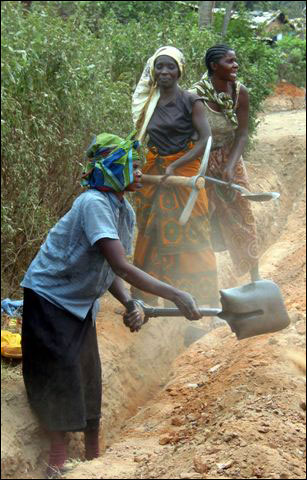
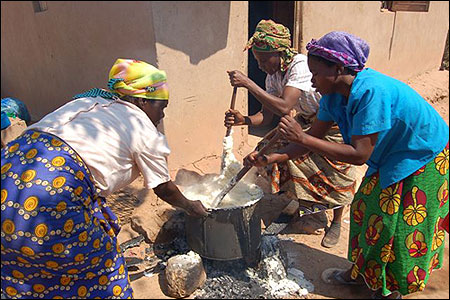
As the local coordinator of the project gave us a gleeful tour of the work that had been completed that day, the volunteers abandoned their picks and shovels for the food a team of the women prepared for them. It soon became clear that the meal marked the end of the work day. As people headed for their homes we expressed a desire to go to the upper end of the compound to see the water tank that supplies the community water taps. We have an ambition to clean the water that people use, and we wanted to see the existing system so we can determine how we can make a difference. Two men volunteered to escort us, and so in just a few moments we were on our way.
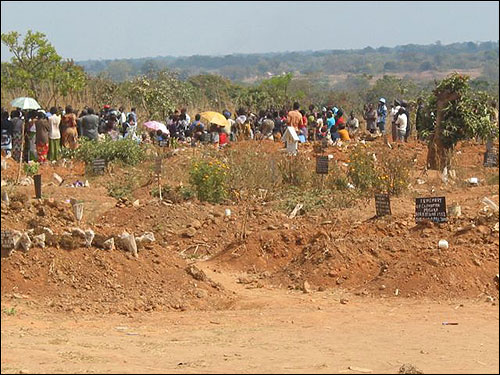
The road to the water tank leads through a gigantic cemetery. We learned that much of the sparse economic activity in Kantolomba results from the neighborhood’s proximity to this cemetery, one of only two in Ndola. People buy things at the tiny market along the cemetery road, and drink at the taverns, on their way to and from the funerals. As we walked we met dozens, perhaps hundreds, of local people returning from a large funeral that had just concluded. Curious, we asked the people we met who had died and learned that it was a fifteen-year-old boy, a resident of Kantolomba, who had lived with his family only a few houses down from the school. He had killed himself by drinking a bottle of chlorine. Horrified, we imagined the suffering that must have driven him to commit that act of violence against himself. As we looked around us at the thousands of graves, many of them new, many of them little more than earth heaped over simple caskets, with hand-lettered signs given the names of those who had died, we understood in a way we hadn’t before the tragedy in the lives of so many in Ndola and all of Africa.

The road carried us above the cemetery to the water tank. Along the way we met scores of women carrying yellow plastic containers of water on their heads. We asked our guides why they carried the water so far when there are spigots right in the compound. They told us that in the compound people are charged one hundred kwacha (about three cents) for every container of water they use. Those who cannot afford to pay—and there are many of these—must hike up to the tank to catch water where it overflows, and in this way avoid the fees.
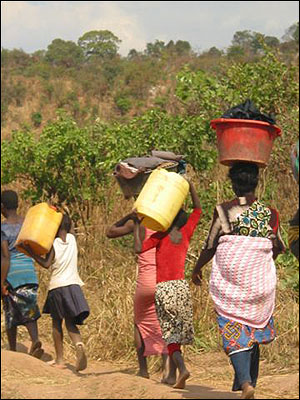
The tank is on the top of the hill above Kantolomba, the highest place in the area. Reaching it finally, we found a breathtaking view of the compound, the green valley below, and the African bush stretching off into the distance. All of us have been touched by the contrast between the great beauty of this place and the great deprivation and suffering happening here. A security guard crawled out of his cardboard office to answer our questions about the tank and about the water that it contained. Satisfied, we walked slowly back to Kantolomba, and then, after arranging to meet again on Saturday, made our way back to town.
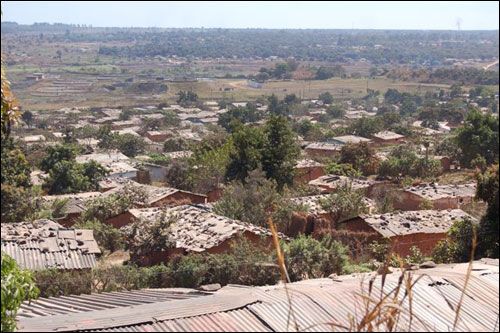
Theresa Kapenda, Coordinator of the Kantolomba Project, joined us in the afternoon at the Hotel Savoy. We talked about the success of the food program, reminding ourselves of what has been accomplished in just one year. We told her how excited we are about our new relationships with Martin, and his willingness to teach new members of the sewing cooperative as it grows. She mentioned she would like to be one of the members of the sewing cooperative and is eager to learn how to sew. That conversation lead to the fact that the Living Compassion web is growing here in Ndola and with that growth, our increasing need for someone to step into the role of “hub.” We asked her who might be a good candidate for Communication Coordinator. She said she would have to think about that. When asked why she would not consider herself a candidate, her response was, “I do not know how to use a computer.” We quickly assured her that that’s not a problem—we will happily give her some lessons. We also discussed the importance of establishing a Living Compassion office space downtown where all the members of the Kantolomba Project could convene to coordinate the work we are involved in, as well as to give Living Compassion credibility as an NGO.
That evening we had extraordinary success with the three meetings we set up for 19 hours (7 PM): 1) Martin arrived with 14 completed bags and two placemats—all original, beautiful, Zambian art. 2) Elvis followed bringing Steven, who was carrying a sample djembe (not sure about the spelling) drum, and 3) Charles, the silk screener, appeared bringing the completed patches for the bags. Keep in mind that these meetings are arranged without benefit of telephones, emails, or cars. Someone goes to find the individual and sets up the meeting. Then that individual must find their way to the appointed place and time via foot or minibus. Having three successful, on-time meetings in a row is nothing short of miraculous—emphasis on the “on-time” which is unheard of!
